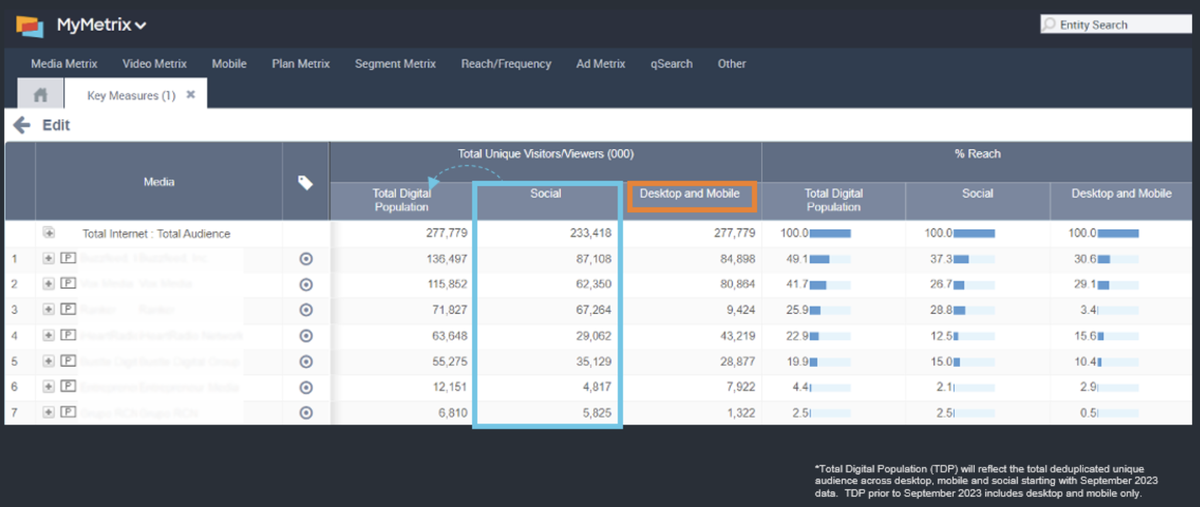Commentary
Who's Duping Whom?
- by Joe Mandese @mp_joemandese, October 26, 2023
In what it claims to be an industry first, Comscore this morning announced it has integrated social metrics in its digital media audience estimates, enabling brands to deduplicate audience reach across desktop, mobile and social campaigns.
The announcement was full of testimonials from Comscore clients -- all publishers -- but it left some big questions unanswered, including exactly what its methodology is for doing it.
"There are major benefits here for publishers and brands who’re now able to achieve social incrementality, and reduced wastage and duplication on key social platforms," a spokesman told the Planning & Buying Insider, adding that the data includes audience estimates for three major social media platforms Facebook, Instagram and X.
advertisement
advertisement
Comscore, which acquired social media tracking platform Shareablee in 2021, has already been promoting products capable of estimating the audience shares of those Big 3 social platforms (see screenshot of one above), but I'm waiting to hear back on some key follow up questions, including:
- What share of the social media universe do Facebook, Instagram and X actually account for, especially given the rise of TikTok, Shapchat, Pinterest and a long swath of long-tail social apps in recent years?
- Is there even a universe estimate for calculating the reach of social media users across platforms?
- And if so, is there a way to develop an audience cume facility capable of estimating reach and frequency curves for social media campaigns?
I'll update this column if and when I get answers back from Comscore on that.
Addendum
Well, Comscore did get back to me on my questions so here's a couple of interesting insights that might shed more light.
One is that Comscore estimates its Big 3 -- Facebook, Instagram and X -- represents 90% of unique visitor reach in the social media universe as defined by its Media Metrix Multi-Platform total audience estimate as of September.
That figure surprises me, because of both the growth of TikTok (which has more than 1 billion active users and accounts for more than 20% of social media users worldwide, as well as smaller, fast-growing platforms like Snapchat, Pinterest, Reddit, and the long-tail of new and emerging social apps.
But I guess it all comes down to how you define a universe, and in this case, it's Comscore's.
As for its explicit deduplication methodology, Comscore explains it this way:
"Comscore utilizes a sophisticated methodological approach, which can be distilled into five straightforward steps for illustrative purposes:
- 1. Measurement and mapping of Comscore's existing digital and social products
- 2. Client engages with Comscore to determine ongoing social brand reach
- 3. Comscore deduplicates audiences from accounts within a social network
- 4. Comscore deduplicates audiences across social platforms
- 5. Comscore deduplicates audiences across social and digital platforms
And here's a screenshot of what the product actually looks like:






Joe: An intriguing announcement by Comscore and good questions. However, you and Comscore consistently use the term "audiience". Audience should always reflect a measurement of persons and their real exposure to content preferably at the Eyes/Ears-On level, i.e., contacts, although, albeit less relevant to advertisers, a measurement of persons-based Likelihood-to-See, LTS or minimlally Opportunity-to-See, OTS, which would also be referred to as audience. I believe Comscore no longer has access to PPM and its assciated persons "exposed" panel. So audience?
As yet another reminder from Ed Papazian, John Grono and myself, so called "viewable impressions" which this likely reflects are not an audience measure but merely a measure of distribution/circulation of content that renders on a surface, i.e., solely a device based measure.
Reach & frequency indeed requires a meaningful relevant universe, so using a base of the major data pirates, Fakebook, Instagram and X? As John McEnroe would say, "Are you kidding?"
To plan campaigns, reach & frequency needs to be based on real persons-based measured audience across all platforms. The industry is correctly very concerned about excessive frequency. If it is based on viewable impressions via a site rendered on a screen (rather than a real audience) that a brand target group never actually saw, per a myriad of cases using attention metrics, then no worries. The CPMs will be fabulous but will be absolutely meaningless.
Bottom line: We all need to insist on terms being defined along with their derivation and measurment techniques - what used to be called a Technical Appendix. The term "impressions", sadly along with "audience", have become completely nebulous and, I suggest, is at the root of excessive fraud as identified by ANA.
Dear Tony,
Total respect for you (as you know) and your expertise here, However, I'm so sorry, that I must correct you.
John McEnroe's quote was "Are you kidding me?"
Marshall: You are just trying to make real persons-based impression???
Tony, your comments boil the whole measurement system down to the fundamental issue. We are not counting what counts.
Your seasoned voice is critical to revealing that the Emperor is wearing no cloths.
Thank you.